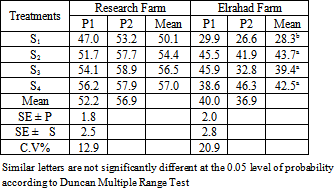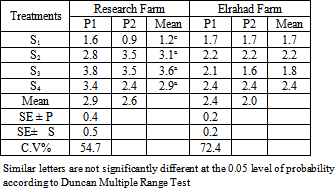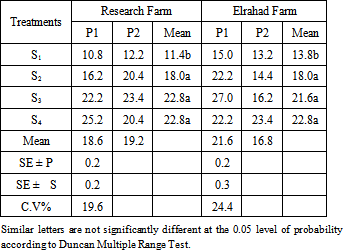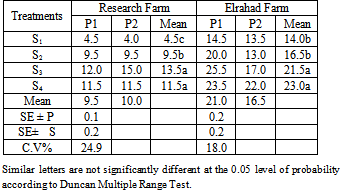Ahmed M. El Naim 1, Elhag H. Khaliefa 1, Khlid A. Ibrahim 2, Feisal M. Ismaeil 1, Moayad M. B. Zaied 1
1Department of Crop Sciences, Faculty of Natural Resources and Environmental Studies, University of Kordofan, Elobeid, Sudan
2Department of Soil and Water Sciences, Faculty of Natural Resources and Environmental Studies, University of Kordofan, Elobeid, Sudan
Correspondence to: Ahmed M. El Naim , Department of Crop Sciences, Faculty of Natural Resources and Environmental Studies, University of Kordofan, Elobeid, Sudan.
| Email: |  |
Copyright © 2012 Scientific & Academic Publishing. All Rights Reserved.
Abstract
Growth plant is the result of transfer of solar radiation in to the photosynthetic processes of green leaf and transmission of photosynthates into increased biomass. Recently, many researchers have manipulated plant row-spacing and direction as well as plant populations within the row, to increase crop production through more efficient use of solar energy. A field experiment was conducted in North Kordofan State of Sudan, to investigate the effect of intra – row spacing (10, 20, 30 and 40cm) and planting stand (two and three plants per stand) on yield and yield components of Hibiscus sabdariffa L. The results showed that, plant population had a significant effect on most of the attributes measured. Closer spacing increased the number of branches per plant, days to 50% flowering, days to 95% physiological maturity, number of calyces per plant, calyces yield (g/plant) and decreased final calyces yield (t/ha). Spacing of 20 cm and three plants per stand gave highest calyces yield (t/ha).
Keywords:
Hibiscus Sabdariffa L, Solar Energy, Crop Density, Calyces
1. Introduction
Roselle (Hibiscus sabdariffa var sabdariffa L.) locally called "kerkadi" is an important crop in tropical and sub-tropical regions. The economical part of the plant is the fleshy calyx (sepals) surrounding the fruit (capsules). In Sudan, fully developed fleshy calyx is peeled off from the fruit by hand and dried naturally under shade to give the dry (calyx), which is the consumable product. The plant, nor-mally grown as annual plant, is 0.5 to 2 meters in height. It has a bushy shape with some what dense canopy of dark green leaves. The color of the calyx plays an important role in determining the quality of the crop. The crimson red color is the characteristic and most popular and desirable color of roselle, while other shades and colors exist, including the white or greenish white color (El Naim and Ahmed, 2010a)). Roselle is an important cash crop in Western Sudan, par-ticularly in Northern Kordofan State, where the largest area of is grown, especially in Elrahad and Um-Rawaba areas.The crop is produced in traditional growing conditions by small-farmers, depending on rainfall and natural soil fertility without using chemical fertilizers or insecticides. A proportion of the crop produced is used locally; however the larger portion of it is exported. It has many industrial and domestic uses. Locally, in the Sudan, it is used as a beverage, where the dried calyx is soaked in water to prepare a colorful cold drink. Traditionally, the product has been used for medicinal purposes for relief of sour throat and for healing wounds as an anti-septic. Recently, the crop has been greatly revived and is currently gaining importance in the manufacture of many small industries, e.g. cosmetics, sweets, sauces, jams, and jellies and a substitute for tea and also used as a coloring material for food and wine. It is also used in medicine, especially with problems related to the digestive tract. The leaves are also used as a pot herb and some varieties are grown for their fiber. The total cultivated roselle area in Sudan during the 1999/2000 season was estimated as 140,000 ha (Elawad, 2001). The main production comes from Western Sudan States, and the most of the exported crop is grown in the Eastern Kordofan localities. Roselle is also scattered in the southern region and south Fung area and recently at Abu Naama in the rain-fed central clay plains of Sudan (Mclean, 1973).The production of Roselle in Sudan is facing many problems, which resulted in: unstable total production. The main yield-limiting factors are: The amount and distribution of rainfall, labour requirement for harvesting which amounts to about half the total cost of production. Moreover, the cultivars used for production are local types, which are characterized by low yield potential. The traditional farmers in the Sudan had sown roselle in a very wide space, crop productivity is still very low. The average yield of farmers was estimated at 227 kg/fed. (Department of statistics and agricultural economics, 1984). On the other hand, there is increasing evidence that the uses of poor cultural practices (especially the practice of wide spacing) as well as traditional cultivars are the main yield limiting factors. Presumably, the adoption of high population densities by farmers meant the avoidance of a climate risk (El Naim and Jabereldar, 2010). Yet, the improvement of yield through manipulation of plant density and use of early maturing cultivars is possible (El Naim et al., 2010a). The crop is considered as a possible future crop, because of its natural production without using any chemical fertilizers and insecticides. Accordingly, the present investigation was carried to examine the effects of intra-row spacing and number of plants per stand on yield and yield components of roselle under rain-fed conditions of north Kordofan, Sudan.
2. Materials and Methods
2.1. Experiment
A field experiment was conducted during two seasons 2004/2005 and 2005/2005 under rain fed in North Kordofan State, Sudan. The climate of the area is arid and semiarid. The soil is sandy with low fertility. Rainfall ranged between 350 and 500 mm. Average maximum daily temperature varied between 300C - 350C most of the year (El Naim and Ahmed, 2010a).The experiment laid out in a Randomized Complete Block Design (RCBD) with four replications. The experimental unit was 4x3.6 meters. In each plot there were 6 rows of four meters length. The row 60cm apart and within row according to the needed spacing .Treatments consisted of intra-row spacing of 10, 20, 30 and 40cm. Designated as S1, S2, S3 and S4, respectively. Two pattern of seeding (two and three plants / stand) were used, designated as P1 and P2, respectively. Sowing was done on 28th of July. The plots were weeded twice, the first one after two weeks from sowing and the second after four weeks from sowing.
2.2. Growth attributes
A sample of ten plants was taken at random from each experimental unit to measure the following growth parameters: - Plant height (cm.): The height of the main stem from the ground level to the tip of the plant.-Number of branches/plant: Number of branches was determined by counting primary reproductive branches.
2.3. Phenological attributes
- Days to 50% flowering: Number of days from planting till 50% of the plants in the row bears at least one open flower.- Days to 95% maturity: Time to 95% physiological maturity was taken as the number of days from planting till 95% of the plants in the rows became yellow, shed their lower leaves and the lowest capsules on the stem were about to split open.
2.4. Yield Attributes
A destructive sample of five plants (up rooting) was taken at random from the five inner rows of experiment plot to measure the following attributes:-Number of calyxes/plant (at maturity).-Calyces yield per plant (g): The calyces of five plants were peeled off from the capsules by using simple hand tools. The calyces were dried under shade to constant weight. Then average calices yield per plant (g) was determined. Final calyces yield (kg / ha). Calculated by using the following formula:The final calyces yield (kg/ha) = calyces yield of plot (kg) x 10000Harvested plot area (m2)
2.5. Statistical Analysis
The collected data were analyzed for the estimation of the statistical parameters according to Gomez and Gomez (1984) procedure for a randomized complete block design.Mean separation: For comparison of means, Duncan Multiple Range Test (DMRT) was used at P ≥ 0.05.
3. Results and Discussion
3.1. Vegetative Growth
Generally, increasing the number of plants per unit area increased competition among plants for soil moisture, nutrients, light and carbon dioxide. Moreover, the low population plants grow as isolated units for most of their early life and interfered less with each other than at higher densities. This might explain the significant effect of crop density on most of the parameters measured in the present study.The results of plant height are shown in table 1. The non significant effect of crop density on mean plant height observed in this study may by attributed to the fact that crop density has often, but not always been associated with increased plant height Supporting evidences were reported by Lazim ( 1973 ) who showed that crop density had no significant effect on plant height Contrasting results were obtained by El Naim and Jabereldar (2010) and El Naim et al. (2011) who stated that an increase in planting population markedly would increase plant height.Difference in plant height was reported by El Naim (2003) and El Naim and Ahmed, (2010b). In the present study, planting exerts significant effect on mean number of branches per plant (Table 2). The number of branches was negatively related with plant population. Similar results were reported by Levy (1985), Kandasamy et al., (1991) and El Naim et al (2010ab) . However Lazim (1973) reported that plant population had no significant effect on branching.Intra-row spacing of 30cm and 20 cm had greater number of branches at the site of research farm, but at Elrahad farm spacing of 40cm and 30cm had a greater number of branches per plant than others. This is due to the low population grew as isolated units for most of early life. The variation in number of branches, per plant was detected by El Naim et al. (2010b). Table 1. Effect of Plant Spacing and Plant Stand on Plant Height (cm) of Roselle
 |
| |
|
Table 2. Effect of Plant Spacing and Plant Stand on Number of Branches per Plant of Roselle
 |
| |
|
3.2. Phenological Attributes
Results of number of days to 50% flowering and to 95% physiological maturity are shown in Table 3and 4. Plant population treatments had no significant effect on time to 50 % flowering. Table 3. Effect of Plant Spacing and Plant Stand on Days to 50% Flowering of Roselle
 |
| |
|
Days taken to flowering were similar when the crop was sown at low or high population. It might be attributed to same time in vegetative growth. This is in line with El Naim (1992) .who showed that spacing had no significant effect on time to 50% flowering in sunflower. This supported the results of El Naim et al. (2010c) who estimated that population size had no effect on peak flowering or physiological maturity. However, Alessi et al, (1977) reported that more number of days are taken to flowering in low population. Increasing spacing increased days to 95% physiological maturity. Lazim, (1973) and El Naim, (2003), reported differences among cultivars in time to 50% flowering and maturity. Table 4. Effect of Plant Spacing and Plant Stand on Days to 95% Physiological Maturity of Roselle
 |
| |
|
3.3. Yield and Yield Attributes
Results of number of calyces are shown in Table 5. The reduction in number of calyces per plant with increasing plant densities observed in this investigation concurs with many researches (Weiss, 1971, Quayyum et al., 1990, Kandasamy et al., 1991); they reported that high plant population reduced both the number of calyces and the number of seeds per capsule. Table 5. Effect of Plant Spacing and Plant Stand on Number of Calyces per Plant Roselle
 |
| |
|
These results may be attributed to the competition between plants and between the different parts of the individual plant under high planting population. In contrast, Lazim, (1973) found that plant population had no significant effect on number of capsules per plant. Also Narayanan and Narayan, (1987) showed that plant population had no influence on number of capsule. In this study, calyces yield per plant increased gradually from (S1 to S4) at the two locations (Table 6). Table 6. Effect of Plant Spacing and Plant Stand on Calyxes Yield (g) per Plant of Roselle
 |
| |
|
Results of calyces yield (t/ha) are shown in Table 7. Calyces yield (t/ha) increase in (S1) and a gradual decreased from (S2 to S4), this may be attributed to the availability of soil moisture, nutrients and light photo-thesis, which is necessary for growth and plant yield. Seed per hole had no significant effect on the number of branches per plant, days to 95% physiological maturity and calyces yield per plant. Adigun (2003) observed that the intra-row spacing did not have any significant effect on both growth and yield parameters.| Table 7. Effect of Plant Spacing and Plant Stand on Final Calyces Yield (t/ha) of Roselle |
| | Treatments | Research Farm | Elrahad Farm | | P1 | P2 | Mean | P1 | P2 | Mean | | S1 | 0.277 | 0.396 | 0.337a | 0.685 | 1.044 | 0.864a | | S2 | 0.309 | 0.462 | 0.385a | 0.586 | 0.585 | 0.850b | | S3 | 0.253 | 0.462 | 0.358a | 0.471 | 0.411 | 0.440bc | | S4 | 0.180 | 0.279 | 0.229b | 0.280 | 0.399 | 0.340c | | Mean | 0.255 | 0.399 | | 0.505 | 0.609 | | | SE ± P | 20.30 | | | 44.30 | | | | SE ± S | 28.80 | | | 62.70 | | | | C.V% | 24.90 | | | 31.80 | | |
|
|
4. Conclusions
Based on the results of this study, the intra -row spacing of 20 cm and two plants per stand is highly recommended in rain-fed to earn maximum calyces yield of roselle in North Kordofan of Sudan.
References
| [1] | Adjun, J. A., 2003. Effect of Intra row spacing and weed control on growth and yield of Roselle (Hibiscus sabdariffa L.). Research and Development Center.University of Agriculture AbeokutaNigeria Agriculture and amp; Environment, ; 3: 91–98 |
| [2] | Alessi, J., Power, J. F. and Zimmerman, D.C., 1977. Sunflower yield and water use as influenced by planting date. population and row spacing. Agron. J., 69:465-469.Ind. J. Agron. 25:562-563 |
| [3] | El-Awad, H. O. Roselle production in Sudan during the seasons (1970/71- 84/85 and 95/96- 2000/01). Elobied research station. Elobied, Sudan. 2001 |
| [4] | El Naim, A.M. Watering intervals and plant population effect on growth and yield of two sunflower hybrids M.Sc. Thesis, Faculty of Agricultural., University of Khartoum.1992 |
| [5] | El Naim A, M. and Jabereldar, A. A., 2010. Effect of Plant density and cultivar on growth and yield of cowpea (Vigna unguiculata L.Walp). Australian Journal of Basic and Applied Sciences, 4(8): 3148-3153 |
| [6] | El Naim, A. M. and Ahmed, S. E., 2010a. Effect of weeding frequencies on growth and yield of two roselle (Hibiscus sabdariffaL) Varieties under rain fed. Australian Journal of Basic and Applied Sciences, 4(9): 4250- 4255 |
| [7] | El Naim A, M. and Ahmed, M. F., 2010b. Effect of Irrigation Intervals and Intra- row Spacing on Yield, Yields Components and Water Use Efficiency of Sunflower(Helianthus annuus L.). Journal of Applied Science Research. 6(9): 1446-1451 |
| [8] | El Naim, A. M., El day, E. M. and Ahmed, A. A., 2010a. Effect of plant density on the performance of some sesame (Sesamum indicum L) cultivars under Rain -fed. Research Journal of Agriculture and Biological Sciences, 6(4): 498-504 |
| [9] | El Naim, A. M., Eldoma, M. A. and Abdalla, A. E. 2010b. Effect of weeding frequencies and plant density on vegetative growth characteristic of groundnut (Arachis hypogaea L.) in North Kordofan of Sudan. International Journal of Applied Biology and Pharmaceutical Technology, 1(3):1188-1193 |
| [10] | Gomez, K.A., Gomez, A. A.. Randomized complete block design analysis. In: Statistical procedures for the agriculture research. John Willy and Sons, New York. 1984 |
| [11] | Kandasamy, G., Balasubara manian, T.N. and Thangavelu., S.(1991). Study on the varietal and spacing interaction in sesame. Sesame and Safflower News letter, 6:41-43 |
| [12] | Lazim, M.E., 1973. Population and cultivar effects on growth and yield of sesame under irrigation. M.Sc. Thesis, Faculty of Agricultural., University of Khartoum |
| [13] | Levy, A., D.,Palevitch and kleifeld, J.,. Evaluation of eseame cultivars and cultural practice in Israel. In: FAO Plant Production and Protection sesame Technical paper, 1985 (66):107-114 |
| [14] | Mclean, K. Roselle (Hibiscus sabdariffa L.), or Karkadi as cultivated edible plants. Agricultural Science. Sudan. 170/ 543/, Project working paper, FAO, Rome. 1973 |
| [15] | Narayanan, A. and Narayan, V., 1987. Yield responses of sesame cultivars to growing season and population. Journal of Oil Seeds Research. 4(2):193-201 |
| [16] | Quayyum, S.M., Rajput, M.A., Ansari, A.H. and Umarani, G.M., 1990. Effect of different inter and intra-row spacing on various agronomic traits in sesame (Sesamum indicum L.). sesame and safflower News letter, (5):23- 28 |

 Abstract
Abstract Reference
Reference Full-Text PDF
Full-Text PDF Full-Text HTML
Full-Text HTML




